My
Amateur Radio History
I was first licensed in
1965 as a Technician with the call sign WA3DJI in Coraopolis, PA--about 18 miles west of
Pittsburgh. My first "station" was a Heathkit HW-30
"Twoer" or "Benton Harbor lunch box" and an 11-element Cushcraft
beam at 70 feet. The Twoer was a crystal-controlled, 5-watt AM/MCW transceiver with
a super-regenerative receiver. The nickname was chosen because the rig was about the
size of a child's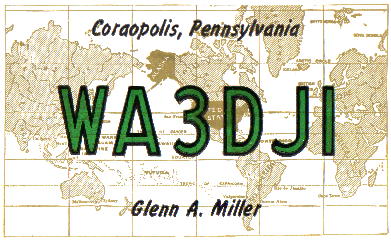 metal lunch box with a carrying handle on the top, just
like a lunch box. (Heath sold 10 meter and 6 meter versions of that rig called, not
surprisingly, a "Tener" (not to be confused with Pavarotti) and a
"Sixer.") My "Twoer" would get swamped when the Steel City
Amateur Radio Club, some 15 miles distant, would fire up their 2 meter kilowatt station--a
major drawback of super-regen.
metal lunch box with a carrying handle on the top, just
like a lunch box. (Heath sold 10 meter and 6 meter versions of that rig called, not
surprisingly, a "Tener" (not to be confused with Pavarotti) and a
"Sixer.") My "Twoer" would get swamped when the Steel City
Amateur Radio Club, some 15 miles distant, would fire up their 2 meter kilowatt station--a
major drawback of super-regen.
I later upgraded my station
with the purchase of an crystal-controlled Ameco TX-62 75-watt AM/CW transmitter and Heathkit SB-300 receiver
with 2-meter converter and a second 11-element beam stacked atop the first. I put up
a 5-element 6 meter beam also, but never did get the 6 meter converter for my receiver, so
I never got on 6. I was still "rockbound" since I couldn't afford the
add-on VFO
for the TX-62. I had a pretty good, moderately strong signal, and worked Florida,
Michigan, and a number of Canadian stations with it. Pretty exciting DX for a
15-year-old kid. I wish I had kept some pictures of my station from back
then.
I was pretty much inactive
from 1969 until 1972--I was busy going to college, working in a steel mill, getting
married, and getting drafted (my draft lottery number was 46!). Instead of taking
the ever-so-enticing 2-year vacation to Southeast Asia with the US Army (you may recall
"The Vietnam Conflict"), I enlisted in the Air Force to become an air traffic
controller. The USAF, in its infinite wisdom, knowing I'd had four years of German
language training, sent me to Russian language school... Well, it was in Monterey, CA, so it
wasn't all that bad.
After the year of language
school and follow-on technical training in San Angelo, TX, in 1973, while stationed in
Germany, I upgraded to Conditional class (a General class equivalent license given by a
volunteer examiner when the applicant is located more than 75 miles from an FCC
examination station) and got the call sign WA3WEN. At that time my station consisted
of a Heathkit SB-303 receiver and SB-401 transmitter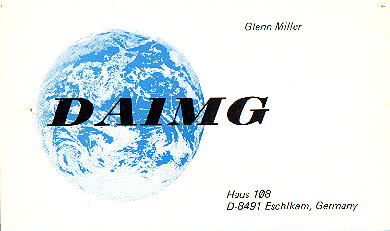 on a
small dresser at the foot of the bed and an indoor random wire running down the hallway
into the kitchen. My German reciprocal call sign was DA1MG and my primary mode of
operation was CW (Morse code). My German landlord never did figure out why his TV
screen went funny in the evenings. I volunteered to operate the unit Military
Auxiliary
Radio System (MARS) (formerly Military Affiliate Radio System) station, running telephone patches and sending written message traffic
to the states for the Americans stationed there. Our little MARS station was extremely active from our
small unit
located on the Czech/West German (back when there still was a Czechoslovakia and
West Germany) border and I had a good group of volunteer operators
to help keep it in operation when the bands were open. I joined MARS as an individual member at about
the time I learned I was going to return to the states.
on a
small dresser at the foot of the bed and an indoor random wire running down the hallway
into the kitchen. My German reciprocal call sign was DA1MG and my primary mode of
operation was CW (Morse code). My German landlord never did figure out why his TV
screen went funny in the evenings. I volunteered to operate the unit Military
Auxiliary
Radio System (MARS) (formerly Military Affiliate Radio System) station, running telephone patches and sending written message traffic
to the states for the Americans stationed there. Our little MARS station was extremely active from our
small unit
located on the Czech/West German (back when there still was a Czechoslovakia and
West Germany) border and I had a good group of volunteer operators
to help keep it in operation when the bands were open. I joined MARS as an individual member at about
the time I learned I was going to return to the states.
I upgraded my license to
Advanced class in January 1976 while stationed at Goodfellow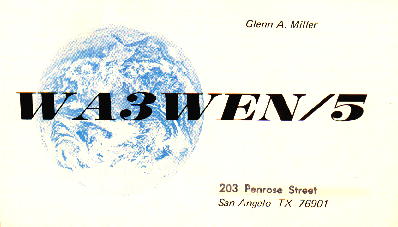 AFB,
San Angelo, TX.
I had to drive to Dallas (about 4 hours away) to take the test at the FCC Field Office
where I failed it the first time and had to wait 30 days to retest. I
1976, I
joined the ranks of the 2-meter FM crowd when I built a Heathkit handie-talkie
(HT) and HW-2036A mobile
rig. I had a humble Ringo Ranger for 2 meters and inverted vee wire antennas for my
HF station.
My shack was located in an enclosed breezeway between the kitchen and
garage. I became a member of the San Angelo Amateur Radio Club and helped build the
club's current clubhouse at Mathis Field just before leaving in 1977 for my next
AF assignment.
AFB,
San Angelo, TX.
I had to drive to Dallas (about 4 hours away) to take the test at the FCC Field Office
where I failed it the first time and had to wait 30 days to retest. I
1976, I
joined the ranks of the 2-meter FM crowd when I built a Heathkit handie-talkie
(HT) and HW-2036A mobile
rig. I had a humble Ringo Ranger for 2 meters and inverted vee wire antennas for my
HF station.
My shack was located in an enclosed breezeway between the kitchen and
garage. I became a member of the San Angelo Amateur Radio Club and helped build the
club's current clubhouse at Mathis Field just before leaving in 1977 for my next
AF assignment.
In 1978, I was assigned to
the Defense Attach� Office at the US Embassy in Moscow, USSR (now Russia), and was off the air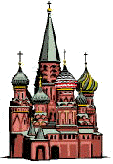 for those 2 years, 5 months, 4 days, and 16 hours (but who was
counting?). I did have my Heathkit SB-303 with me and I listened to the amateur bands from my
living room. I had the embassy check to see what the possibilities were of getting
some sort (any sort) of reciprocal license, but the best they could do was
"perhaps" get me permission to operate a "collective" (club) station. (The Soviet paranoid feeling, I'm certain, was that all
people working at the embassy were spies, and giving one of those spies permission to
operate a transmitter from his apartment? "Ha!. You make a joke,
nyet? I laugh on you.") It would have been interesting. I once
drove past the Central Radio Club (the Soviet equivalent of the ARRL) building, but didn't
stop in. It was while I was in Moscow, in February 1980, that I joined the Radio Amateur Satellite Corporation (AMSAT).
for those 2 years, 5 months, 4 days, and 16 hours (but who was
counting?). I did have my Heathkit SB-303 with me and I listened to the amateur bands from my
living room. I had the embassy check to see what the possibilities were of getting
some sort (any sort) of reciprocal license, but the best they could do was
"perhaps" get me permission to operate a "collective" (club) station. (The Soviet paranoid feeling, I'm certain, was that all
people working at the embassy were spies, and giving one of those spies permission to
operate a transmitter from his apartment? "Ha!. You make a joke,
nyet? I laugh on you.") It would have been interesting. I once
drove past the Central Radio Club (the Soviet equivalent of the ARRL) building, but didn't
stop in. It was while I was in Moscow, in February 1980, that I joined the Radio Amateur Satellite Corporation (AMSAT).
I left Moscow at the peak
of the sunspot cycle in June 1980 (just before the Olympic Games that no one went to) and
was assigned to Fort George G.
Meade, MD. There I sold my Heath "twins" and made a pilgrimage to the
Dayton Hamvention in 1981 where I
purchased a Kenwood TS-530S HF transceiver, matching speaker, and antenna tuner.
That, along with a Heathkit antenna tuner connected to a 5-band trap vertical antenna, was
my station in the corner of the bedroom in our on-post government accommodations. I replaced my Heath HT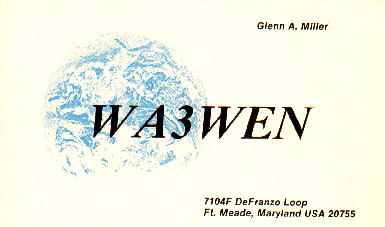 with an Icom
IC-2AT--the best little HT ever built. I also got more interested in the amateur
radio satellite program. I used a Kenwood TR-9130 all-mode 2-meter rig, an Icom
IC-402 3-watt SSB/CW transceiver driving a 40-watt home-brew amplifier, and an Advanced
Receiver Research 2-to-10 meter converter into my TS-530S. The antennas were
Cushcraft 10-element, 2 meter and 20-element, 70 cm crossed yagis. Two light-duty TV
rotors did the azimuth/elevation duty. I think I worked everyone within range using
the Orbiting Satellite Carrying Amateur Radio (OSCAR) in my last year at Fort Meade.
Trying to manipulate two rotors to track the satellite and send Morse on a Vibroplex bug
was a challenge at times, but it was great fun.
with an Icom
IC-2AT--the best little HT ever built. I also got more interested in the amateur
radio satellite program. I used a Kenwood TR-9130 all-mode 2-meter rig, an Icom
IC-402 3-watt SSB/CW transceiver driving a 40-watt home-brew amplifier, and an Advanced
Receiver Research 2-to-10 meter converter into my TS-530S. The antennas were
Cushcraft 10-element, 2 meter and 20-element, 70 cm crossed yagis. Two light-duty TV
rotors did the azimuth/elevation duty. I think I worked everyone within range using
the Orbiting Satellite Carrying Amateur Radio (OSCAR) in my last year at Fort Meade.
Trying to manipulate two rotors to track the satellite and send Morse on a Vibroplex bug
was a challenge at times, but it was great fun.
In 1983 I was reassigned to
Monterey, CA, for intermediate Russian language training where I got interested in
radioteletype (RTTY). I built a Heath terminal unit and fed it with a newly acquired
Commodore 64--pretty much state-of-the-art at the time. My station in Monterey was
pretty modest due to the antenna restrictions imposed by my landlord who never did
understand what amateur radio was all about ("It's CB, ain't it?"). My shack was again located in the corner of our
bedroom, much to my wife's dismay. While in Monterey I was a member of the
Naval Postgraduate
School Amateur Radio Club.
In 1984 I transferred to
Munich, Germany, where I landed the reciprocal call sign DA1CM. A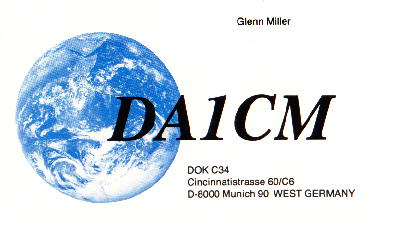 storage room in our apartment building attic was ideally suited for the ham shack (and, more importantly to my wife,
got it out of the bedroom). I used a Butternut Butterfly beam on 10-20 meters (only
slightly better than no antenna at all) and a trap dipole on 30, 40 and 80 meters.
At the urging of Kurt/W3AKZ/DA1ZE, I became a
bier-drinking member of DOK C34 of the Deutscher
Amateur Radio Club (DARC) (a DOK is
a local chapter of the DARC). I discovered packet radio while in Munich and had a
great time talking with other Americans (GIs mostly) and Germans on 2 meter packet using a
Heathkit HD-3030 terminal node controller (TNC). I retired my TS-530S in favor of a TS-440S, keeping the 530 as
a backup rig. The addition of a Kantronics All-Mode (KAM) put me on AMTOR (Amateur
Telecommunicating Over Radio--a modified form of RTTY with error detection and
correction). My Heathkit building continued with an SB-1000 kilowatt HF amplifier,
station monitor, audio filter, digital voltmeter, and other smaller kits. I once
counted up the number
storage room in our apartment building attic was ideally suited for the ham shack (and, more importantly to my wife,
got it out of the bedroom). I used a Butternut Butterfly beam on 10-20 meters (only
slightly better than no antenna at all) and a trap dipole on 30, 40 and 80 meters.
At the urging of Kurt/W3AKZ/DA1ZE, I became a
bier-drinking member of DOK C34 of the Deutscher
Amateur Radio Club (DARC) (a DOK is
a local chapter of the DARC). I discovered packet radio while in Munich and had a
great time talking with other Americans (GIs mostly) and Germans on 2 meter packet using a
Heathkit HD-3030 terminal node controller (TNC). I retired my TS-530S in favor of a TS-440S, keeping the 530 as
a backup rig. The addition of a Kantronics All-Mode (KAM) put me on AMTOR (Amateur
Telecommunicating Over Radio--a modified form of RTTY with error detection and
correction). My Heathkit building continued with an SB-1000 kilowatt HF amplifier,
station monitor, audio filter, digital voltmeter, and other smaller kits. I once
counted up the number of Heathkits I'd assembled over the
years--53. I picked up an MFJ 1.5 kW antenna tuner to handle the amplifier on those
rare occasions when I used it. While in Munich, I upgraded my license to Amateur Extra
Class, and became a volunteer examiner under the ARRL/Volunteer Examiner
Coordinator program administering amateur radio license examinations in Munich.
I had the good fortune of visiting the Ham Radio International Amateur Radio Exhibition
(the European equivalent of the Dayton Hamvention) with Sandy/KG7NN/DA2BX in 1987 and with
Kurt/DA1ZE in
1988--an interesting experience. I taught or assisted in teaching three license classes
while in Munich, helping about a dozen people get their first licenses. Although I had never had much interest in DXing (contacting
distant stations in foreign countries), Bob/WU5T/DJ�MBC challenged me to get the DXCC
Award (for contacting 100 countries and confirming those contacts with snail-mailed QSL
cards). I made a run for DXCC during my last 9 months in Munich and managed to get
the last needed QSL before returning stateside. The first 100 countries are
relatively easy to get from Europe, I have to admit. (I think I beat Bob, but I
never did find out for sure.) I continued to be active in the AF MARS program while stationed in
Munich. I served as Region Operations Analysis Manager (ROAM) for two years and was
net control station for the European Region AF MARS nets twice a week for three years.
I ran some phone patches to the states for military personnel stationed in Munich and
also sent written message traffic to the states on the overseas voice circuits.
of Heathkits I'd assembled over the
years--53. I picked up an MFJ 1.5 kW antenna tuner to handle the amplifier on those
rare occasions when I used it. While in Munich, I upgraded my license to Amateur Extra
Class, and became a volunteer examiner under the ARRL/Volunteer Examiner
Coordinator program administering amateur radio license examinations in Munich.
I had the good fortune of visiting the Ham Radio International Amateur Radio Exhibition
(the European equivalent of the Dayton Hamvention) with Sandy/KG7NN/DA2BX in 1987 and with
Kurt/DA1ZE in
1988--an interesting experience. I taught or assisted in teaching three license classes
while in Munich, helping about a dozen people get their first licenses. Although I had never had much interest in DXing (contacting
distant stations in foreign countries), Bob/WU5T/DJ�MBC challenged me to get the DXCC
Award (for contacting 100 countries and confirming those contacts with snail-mailed QSL
cards). I made a run for DXCC during my last 9 months in Munich and managed to get
the last needed QSL before returning stateside. The first 100 countries are
relatively easy to get from Europe, I have to admit. (I think I beat Bob, but I
never did find out for sure.) I continued to be active in the AF MARS program while stationed in
Munich. I served as Region Operations Analysis Manager (ROAM) for two years and was
net control station for the European Region AF MARS nets twice a week for three years.
I ran some phone patches to the states for military personnel stationed in Munich and
also sent written message traffic to the states on the overseas voice circuits.
After nearly 5 years in
Munich, I transferred to my present location in San Angelo. Living in our own house
for the first time since I joined the Air Force allowed me to build a radio shack in a separate room. For the first time ever, I have
a tower for my antennas. I also decided to trade in my 3-land call sign for a
5-district call since we'd decided San Angelo was going to be my retirement location. I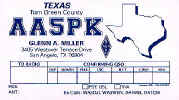 still
use an inverted vee for the lower bands. And
I got a pretty good deal on a Heath Twin-Bander (2 mtr/70 cm) transceiver. I picked up a
Kenwood TR-7800 for my packet station, freeing the TR-9130 for future satellite work (the
antennas and other satellite stuff collected dust until I could rearrange to get the satellite station set back
up in 2008). The TR-9130 was given away when I replaced it with an Icom
IC-910H in 2007. I picked up an
Kenwood TM-G707A dual-bander for installation in my pickup truck. My Garmin global
positioning system (GPS) receiver kept me from getting lost in the wilds of West
Texas, but my XYL got me a Garmin N�vi for Christmas in 2007. A quantum
leap over the old GPS III+. I plan to use the GPS III+ for APRS one of
these days. And, 2008 saw the purchase of an Icom IC-746 Pro to replace my
TS-440S which started exhibiting that notorious VCO PLL unlock problem it's so
famous for. And, in 2010, I purchased an Icom IC-7000. Plans are to
place that into mobile service one of these days.
still
use an inverted vee for the lower bands. And
I got a pretty good deal on a Heath Twin-Bander (2 mtr/70 cm) transceiver. I picked up a
Kenwood TR-7800 for my packet station, freeing the TR-9130 for future satellite work (the
antennas and other satellite stuff collected dust until I could rearrange to get the satellite station set back
up in 2008). The TR-9130 was given away when I replaced it with an Icom
IC-910H in 2007. I picked up an
Kenwood TM-G707A dual-bander for installation in my pickup truck. My Garmin global
positioning system (GPS) receiver kept me from getting lost in the wilds of West
Texas, but my XYL got me a Garmin N�vi for Christmas in 2007. A quantum
leap over the old GPS III+. I plan to use the GPS III+ for APRS one of
these days. And, 2008 saw the purchase of an Icom IC-746 Pro to replace my
TS-440S which started exhibiting that notorious VCO PLL unlock problem it's so
famous for. And, in 2010, I purchased an Icom IC-7000. Plans are to
place that into mobile service one of these days.
 I retired from the Air
Force on April 30, 1994, and started a job with the city of San Angelo as a
telecommunications operator at the police department the following day. In September
1996, all public safety dispatching became a separate department (Public Safety
Communications) in a separate communications center
where I was supervisor on the midnight shift (yawn) for a little over 3 years. A lack of
sleep and way too much bad management forced me to look for something to do
elsewhere.
After taking a month off to get adjusted to sleeping at night again, I worked
part-time for two months as a customer assistance representative for Mitsubishi
Motors. In October 1999, I took a full-time job as an assistant Veterans' County
Service Officer working for one of my former
USAF supervisors. In May 2002, I began work with the Texas Workforce
Commission as a veterans employment counselor. And, finally, in April 2004, I took a job
with Uncle Sam as a human resources technician at Goodfellow AFB where I plan to
be until final retirement in 2013 when my XYL becomes eligible to retire from
civil service. I've worked for the city,
county, state and the fed since I retired.
I retired from the Air
Force on April 30, 1994, and started a job with the city of San Angelo as a
telecommunications operator at the police department the following day. In September
1996, all public safety dispatching became a separate department (Public Safety
Communications) in a separate communications center
where I was supervisor on the midnight shift (yawn) for a little over 3 years. A lack of
sleep and way too much bad management forced me to look for something to do
elsewhere.
After taking a month off to get adjusted to sleeping at night again, I worked
part-time for two months as a customer assistance representative for Mitsubishi
Motors. In October 1999, I took a full-time job as an assistant Veterans' County
Service Officer working for one of my former
USAF supervisors. In May 2002, I began work with the Texas Workforce
Commission as a veterans employment counselor. And, finally, in April 2004, I took a job
with Uncle Sam as a human resources technician at Goodfellow AFB where I plan to
be until final retirement in 2013 when my XYL becomes eligible to retire from
civil service. I've worked for the city,
county, state and the fed since I retired.
Even though we
have an air force base in town, I'm one of only four active
AF MARS members in San Angelo--go figure. My current MARS call sign is
AFA6HM.
I've served four
terms as president of The San Angelo Amateur
Radio Club, having also previously served three terms as
secretary/treasurer and activities
manager. I edited
and published the club's newsletter, The
Kilo-What, for 15 years (I "retired" in June 2007). I'm a volunteer examiner for our club's license
testing efforts and an ARRL registered instructor for license classes. And last, but not least, I'm the Webmaster of the club's
Web
site. Visit our club's web site!
 Back to my home page
Back to my home page
If your browser is enabled, the
musical selection playing is "Always Look on the Bright Side of Life" from the
motion picture "Monty Python's The Life of Brian"
 metal lunch box with a carrying handle on the top, just
like a lunch box. (Heath sold 10 meter and 6 meter versions of that rig called, not
surprisingly, a "Tener" (not to be confused with Pavarotti) and a
"Sixer.") My "Twoer" would get swamped when the Steel City
Amateur Radio Club, some 15 miles distant, would fire up their 2 meter kilowatt station--a
major drawback of super-regen.
metal lunch box with a carrying handle on the top, just
like a lunch box. (Heath sold 10 meter and 6 meter versions of that rig called, not
surprisingly, a "Tener" (not to be confused with Pavarotti) and a
"Sixer.") My "Twoer" would get swamped when the Steel City
Amateur Radio Club, some 15 miles distant, would fire up their 2 meter kilowatt station--a
major drawback of super-regen. on a
small dresser
on a
small dresser 
 for those 2 years, 5 months, 4 days, and 16 hours (but who was
counting?). I did have my Heathkit SB-303 with me and I listened to the amateur bands from my
living room. I had the embassy check to see what the possibilities were of getting
some sort (any sort) of reciprocal license, but the best they could do was
"perhaps" get me permission to operate a "collective" (club) station. (The Soviet paranoid feeling, I'm certain, was that all
people working at the embassy were spies, and giving one of those spies permission to
operate a transmitter from his apartment? "Ha!. You make a joke,
nyet? I laugh on you.") It would have been interesting. I once
drove past the Central Radio Club (the Soviet equivalent of the ARRL) building, but didn't
stop in. It was while I was in Moscow, in February 1980, that I joined the
for those 2 years, 5 months, 4 days, and 16 hours (but who was
counting?). I did have my Heathkit SB-303 with me and I listened to the amateur bands from my
living room. I had the embassy check to see what the possibilities were of getting
some sort (any sort) of reciprocal license, but the best they could do was
"perhaps" get me permission to operate a "collective" (club) station. (The Soviet paranoid feeling, I'm certain, was that all
people working at the embassy were spies, and giving one of those spies permission to
operate a transmitter from his apartment? "Ha!. You make a joke,
nyet? I laugh on you.") It would have been interesting. I once
drove past the Central Radio Club (the Soviet equivalent of the ARRL) building, but didn't
stop in. It was while I was in Moscow, in February 1980, that I joined the with an Icom
IC-2AT--the best little HT ever built. I also got more interested in the amateur
radio satellite program. I used a Kenwood TR-9130 all-mode 2-meter rig, an Icom
IC-402 3-watt SSB/CW transceiver driving a 40-watt home-brew amplifier, and an Advanced
Receiver Research 2-to-10 meter converter into my TS-530S. The antennas were
Cushcraft 10-element, 2 meter and 20-element, 70 cm crossed yagis. Two light-duty TV
rotors did the azimuth/elevation duty. I think I worked everyone within range using
the Orbiting Satellite Carrying Amateur Radio (OSCAR) in my last year at Fort Meade.
Trying to manipulate two rotors to track the satellite and send Morse on a Vibroplex bug
was a challenge at times, but it was great fun.
with an Icom
IC-2AT--the best little HT ever built. I also got more interested in the amateur
radio satellite program. I used a Kenwood TR-9130 all-mode 2-meter rig, an Icom
IC-402 3-watt SSB/CW transceiver driving a 40-watt home-brew amplifier, and an Advanced
Receiver Research 2-to-10 meter converter into my TS-530S. The antennas were
Cushcraft 10-element, 2 meter and 20-element, 70 cm crossed yagis. Two light-duty TV
rotors did the azimuth/elevation duty. I think I worked everyone within range using
the Orbiting Satellite Carrying Amateur Radio (OSCAR) in my last year at Fort Meade.
Trying to manipulate two rotors to track the satellite and send Morse on a Vibroplex bug
was a challenge at times, but it was great fun. storage room in our apartment building attic was ideally suited for
storage room in our apartment building attic was ideally suited for  of Heathkits I'd assembled over the
years--53. I picked up an MFJ 1.5 kW antenna tuner to handle the amplifier on those
rare occasions when I used it. While in Munich, I upgraded my license to Amateur Extra
Class, and became a volunteer examiner under the ARRL/Volunteer Examiner
Coordinator program administering amateur radio license examinations in Munich.
I had the good fortune of visiting the Ham Radio International Amateur Radio Exhibition
(the European equivalent of the Dayton Hamvention) with Sandy/KG7NN/DA2BX in 1987 and with
Kurt/DA1ZE in
1988--an interesting experience. I taught or assisted in teaching three license classes
while in Munich, helping about a dozen people get their first licenses. Although I had never had much interest in DXing (contacting
distant stations in foreign countries), Bob/WU5T/DJ�MBC challenged me to get the DXCC
Award (for contacting 100 countries and confirming those contacts with snail-mailed QSL
cards). I made a run for DXCC during my last 9 months in Munich and managed to get
the last needed QSL before returning stateside. The first 100 countries are
relatively easy to get from Europe, I have to admit. (I think I beat Bob, but I
never did find out for sure.) I continued to be active in the AF MARS program while stationed in
Munich. I served as Region Operations Analysis Manager (ROAM) for two years and was
net control station for the European Region AF MARS nets twice a week for three years.
I ran some phone patches to the states for military personnel stationed in Munich and
also sent written message traffic to the states on the overseas voice circuits.
of Heathkits I'd assembled over the
years--53. I picked up an MFJ 1.5 kW antenna tuner to handle the amplifier on those
rare occasions when I used it. While in Munich, I upgraded my license to Amateur Extra
Class, and became a volunteer examiner under the ARRL/Volunteer Examiner
Coordinator program administering amateur radio license examinations in Munich.
I had the good fortune of visiting the Ham Radio International Amateur Radio Exhibition
(the European equivalent of the Dayton Hamvention) with Sandy/KG7NN/DA2BX in 1987 and with
Kurt/DA1ZE in
1988--an interesting experience. I taught or assisted in teaching three license classes
while in Munich, helping about a dozen people get their first licenses. Although I had never had much interest in DXing (contacting
distant stations in foreign countries), Bob/WU5T/DJ�MBC challenged me to get the DXCC
Award (for contacting 100 countries and confirming those contacts with snail-mailed QSL
cards). I made a run for DXCC during my last 9 months in Munich and managed to get
the last needed QSL before returning stateside. The first 100 countries are
relatively easy to get from Europe, I have to admit. (I think I beat Bob, but I
never did find out for sure.) I continued to be active in the AF MARS program while stationed in
Munich. I served as Region Operations Analysis Manager (ROAM) for two years and was
net control station for the European Region AF MARS nets twice a week for three years.
I ran some phone patches to the states for military personnel stationed in Munich and
also sent written message traffic to the states on the overseas voice circuits. still
use an inverted vee for the lower bands. And
I got a pretty good deal on a Heath Twin-Bander (2 mtr/70 cm) transceiver. I picked up a
Kenwood TR-7800 for my packet station, freeing the TR-9130 for future satellite work (the
antennas and other satellite stuff collected dust until I could rearrange to get the satellite station set back
up in 2008). The TR-9130 was given away when I replaced it with an Icom
IC-910H in 2007. I picked up an
Kenwood TM-G707A dual-bander for installation in my pickup truck. My Garmin global
positioning system (GPS) receiver kept me from getting lost in the wilds of West
Texas, but my XYL got me a Garmin N�vi for Christmas in 2007. A quantum
leap over the old GPS III+. I plan to use the GPS III+ for APRS one of
these days. And, 2008 saw the purchase of an Icom IC-746 Pro to replace my
TS-440S which started exhibiting that notorious VCO PLL unlock problem it's so
famous for. And, in 2010, I purchased an Icom IC-7000. Plans are to
place that into mobile service one of these days.
still
use an inverted vee for the lower bands. And
I got a pretty good deal on a Heath Twin-Bander (2 mtr/70 cm) transceiver. I picked up a
Kenwood TR-7800 for my packet station, freeing the TR-9130 for future satellite work (the
antennas and other satellite stuff collected dust until I could rearrange to get the satellite station set back
up in 2008). The TR-9130 was given away when I replaced it with an Icom
IC-910H in 2007. I picked up an
Kenwood TM-G707A dual-bander for installation in my pickup truck. My Garmin global
positioning system (GPS) receiver kept me from getting lost in the wilds of West
Texas, but my XYL got me a Garmin N�vi for Christmas in 2007. A quantum
leap over the old GPS III+. I plan to use the GPS III+ for APRS one of
these days. And, 2008 saw the purchase of an Icom IC-746 Pro to replace my
TS-440S which started exhibiting that notorious VCO PLL unlock problem it's so
famous for. And, in 2010, I purchased an Icom IC-7000. Plans are to
place that into mobile service one of these days. I retired from the Air
Force on April 30, 1994, and started a job with the city of San Angelo as a
telecommunications operator at the police department the following day. In September
1996, all public safety dispatching became a separate department (Public Safety
Communications) in a separate
I retired from the Air
Force on April 30, 1994, and started a job with the city of San Angelo as a
telecommunications operator at the police department the following day. In September
1996, all public safety dispatching became a separate department (Public Safety
Communications) in a separate